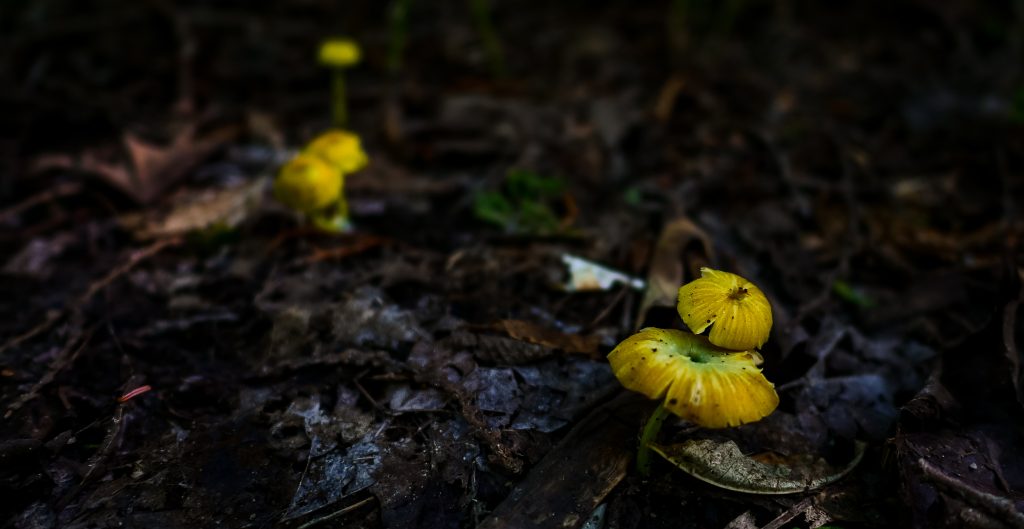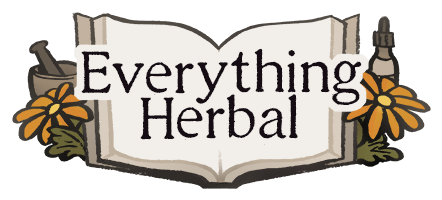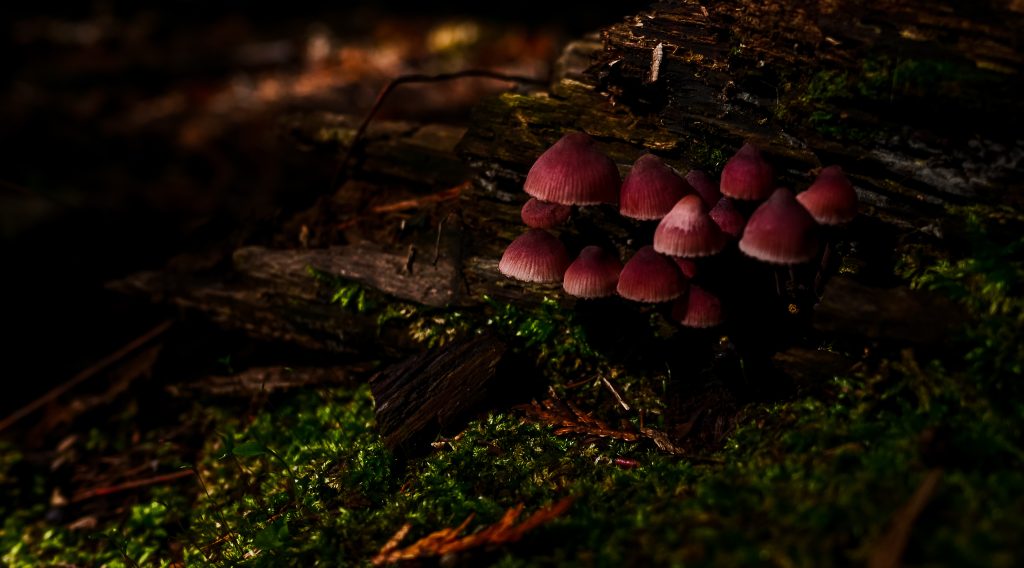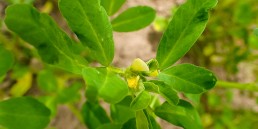An Ancient Medicine
The use of mushrooms as food and medicine stretches back thousands of years, and can be observed in every culture of the world. Recently, a growing body of scientific and clinical evidence has amassed which supports many facets of the traditional use of mushrooms as medicine. Mycotherapy – the science of healing with mushrooms – is fully incorporated into traditional Western herbalism, as well as Traditional Chinese and Japanese medical systems, where mushrooms have always been highly revered as powerful healing agents for a wide variety of ailments and illnesses ranging from acute to chronic. Dr. Walter Ardigò, physician and researcher specializing in mycotherapy, suggests that mushrooms have such a strong affinity for so many diverse disease conditions in the human organism because of their biological similarities to human beings:
“Medicinal mushrooms are more similar to human beings than to plants. Like human beings, they need oxygen to live, eliminate carbondioxide and have no absolute need for light. The two also have similar biological mechanisms, such as immunity, cleansing and elimination of excess fluids” (Ardigò: 2017, 20).
Fungi play innumerable essential roles in maintaining the health and functionality of the world’s diverse ecosystems. It may surprise you, but the largest living being on earth has been declared to be a 2,384 acre large mycelial network (of the species Armillaria ostoyae, also known as honey mushrooms) located in the Blue Mountains of the state of Oregon. Fungi are responsible for processes involving the transmission of information amongst living organisms; they do this by way of electrical impulses that are sent underground through long, thread-like structures called hyphae, which expand to form mycelial networks. Many plants rely on mycorrhizal networks, which facilitate symbiotic associations between plants and fungi. Mycorrhizal networks serve to connect plants together and transfer essentials such as water, carbon, nitrogen, and a host of other nutrients and minerals.
Fungi also play an absolutely pivotal role when it comes to natural processes involving breakdown, decay and regeneration (e.g. by way of returning nutrients to the air and soil). Fungi do no simply decompose, but more accurately work to recompose elements of the environment. Fungi thereby make possible many of the processes of natural evolution. Fungi can be said to occupy a middle ground between the living and the dead; they are what allow for the continuum of coming into being and passing away to exist in the first place. As mycologist Peter McCoy expresses:
“Along the border of living and dying, mycelia sense and digest, interpret and destroy. More visibly than the bacteria with which they work, the fungi walk between worlds, acting as custodians of the darkness. Some species are so intimately tied to decay that they primarily live and fruit from dead animal parts” (McCoy: 2016, 76).
The Power of Mushrooms
That fungi are “custodians of the darkness” is suggestive of the fact that, when used as medicine, mushrooms can be helpful in a wide variety of psycho-emotional disorders, including many varieties of anxiety and depression, trauma and grief. As we will see, mushrooms such as Reishi can help to bring our unconscious defense patterns to light, making the darkness conscious through the metabolization of emotional experience. Additionally, when we understand the role that fungi play in decomposition and regeneration, we can also begin to understand how and why medicinal mushrooms prove so useful in diseases such as cancer and opportunistic infections such as might be associated with HIV. Both of these conditions involve uncontrolled, proliferative growth that the body is unable to keep in check. Medicinal mushrooms act in such a way as to regulate the functioning of the immune system, keeping such pathological conditions in check or preventing their onset in the first place.
Many of our medicinal mushrooms act as adaptogens. In general, adaptogens serve to strengthen the natural defenses of the body, and help the body adapt to non-specific stressors (including physical performance and endurance, as well as psychological and emotional stress). Adaptogens have a normalizing or balancing effect on the whole organism, helping to promote equilibrium amongst different body systems and processes. Many adaptogens have a direct strengthening and rehabilitative effect on the adrenal glands, are known to help to regulate blood sugar levels, and to balance and stabilize hormone levels. Used in moderation, adaptogens are generally very well tolerated by most people and help to promote an overall harmonizing and tonifying effect on the body and mind.
Shiitake
Lentinula edodes
Shiitake is a well-known culinary and medicinal mushroom that has been used in Asian cuisine for at least 2000 years, with cultivation techniques originating in Japan about 700 years ago. The name “shiitake” is derived from the Japanese words “shii” meaning oak, and “take” meaning mushroom: suggesting that shiitake is the mushroom that grows on oak trees. Shiitake is the second most consumed mushroom worldwide, second only to agaricus mushrooms. In Japanese culture, shiitake is considered to be a tonic food substance which serves to increase energy, foster the resilience of the body, reduce the susceptibility to chronic degenerative diseases, aid in convalescence, and slow the aging and deterioration process.
Many clinical studies on Shiitake focus on its production of the beta-glucan lentinan. Beta-glucans are a type of fiber that has an affinity for promoting the health of the heart, regulating the function of the immune system, and balancing cholesterol and blood sugar levels (shiitake is known to be an excellent food for diabetic patients). Lentinan is a unique beta-glucan that is found in shiitake mushrooms, which has been given increasing attention in recent years due to its utility in assisting in the treatment of cancer and HIV infection. Many of the medicinal properties of lentinan relate to its ability to stimulate macrophages (a type of white blood cell in the immune system that engulfs and digests pathogens including cancer cells, foreign substances and harmful microbes), T-cells (which target specific foreign particles in the body), B-cells (an important component of the adaptive immune system), and NK cells (essential to the functioning of the innate immune system). Researchers have also focused on shiitake’s production of the polysaccharides LEM and LAP, which possess significant antitumor activity. LEM has been shown to stimulate the proliferation of a specific type of T-cell which can help to neutralize hepatitis and slow and prevent the rapid development of HIV infection. Shiitake possesses anti-viral and antioxidant properties, in part due to the presence of the essential trace mineral selenium. Selenium plays a role in many bodily functions, especially maintaining thyroid hormone metabolism and DNA synthesis, safeguarding the body against oxidative damage and infection. Shiitake is also useful in diseases of the intestine, respiratory tract, liver, bones and teeth. It has been called on for centuries as a household remedy to help treat flu and fever, coughs and colds and allergies.
There is a growing body of research on shiitake mushroom, which was the first mushroom to receive in depth research by modern scientists. As Ardigò explains:
shiitake “became renowned in 1964, after the Japanese health authorities decided to promote a series of epidemiological studies on the prevalence and distribution of the main chronic diseases throughout the country. The results revealed a very peculiar situation: in two areas of the country, disease was almost entirely absent, and the population was very long-lived” (Ardigò: 2017, 287)
The homeopath Massimo Mangialavori relates that:
“there are many myths and customs associated with shiitake. One belief is that this mushroom grows best in the company of other nurse logs, rather than by itself. Some say the mushroom is sensitive to the attitude of those who tend the mushroom: positive people allow it to flourish; disagreeable people discourage its growth” (Mangialavori: 2017, 263).
Maitake
Grifola frondosa
The general uses of maitake mushroom include the treatment of obesity (the alpha-glucosidase inhibitor contained in maitake decreases the amount of starch that is digested into sugar), diabetes type 1 and 2 (maitake lowers blood glucose levels and enhances insulin sensitivity), a wide variety of tumors but especially those of the stomach and lungs (maitake enhances macrophage activity in the body), leukemia, allergies, and HIV. Maitake has an affinity for conditions of the heart, including hypertension and high VLDL and HDL cholesterol levels. It is also known as a hepatoprotective mushroom, serving to enhance the overall health and functionality of the liver while simultaneously protecting it from damage. It is widely used in hepatocellular cancer and other pathological and chronic conditions that affect the liver, such as hepatitis.
Herbalist Richard Bray comments on the geography and preferred growing conditions of maitake and on the origin of one of its common names, hen of the woods:
“Maitake grows primarily at the base of oak trees in eastern North America, China, and Japan. This polypore mushroom starts as a small fruiting body, about the size of a potato, and when mature reaches up to 2-7 cm across. They grow especially big in Japan, often reaching 45kg. It is known as the “king of mushrooms” there with good reason! Maitake mushrooms grow multitudes of overlapping grayish-brown fronds, which give it the appearance of a hen sitting in the woods, hence the common name” (Bray: 2020, 48).
Lion’s Mane
Hericium erinaceus
Lion’s mane is most well known for its ability to induce brain tissue regeneration and to enhance perceptual capacities. If you look at either fresh or dried lion’s mane, you’ll observe that it appears structurally similar to the human brain and its nerve fibers – a clear example of the doctrine of signatures. Lion’s mane is used in the treatment of such issues as dementia, Parkinson’s, and diabetic neuropathy. The polysaccharides and polypeptides in Lion’s mane help to enhance immune function and have proven useful in stomach, esophageal, and skin cancers. Lion’s mane can pass through the blood-brain barrier and as such is quite valuable for targeting lyme disease spirochetes that have invaded the brain. Lion’s mane directs the spirochetes into the bloodstream where there’s a chance of them being eradicated. There are a growing number of studies that suggest the utility of lion’s mane in treating a variety of types of depression and mood disorders, including hormonally related anxiety disorders.
Indications from Traditional Chinese Medicine include memory disorders, difficulty concentrating, and a general picture of deficient cognitive function and abilities. Traditional Chinese Medicine also recognizes the use of lion’s mane in promoting and maintaining the health of the kidneys, heart, liver, lungs and spleen. It is thought to enhance overall strength and vitality, and facilitate ease of digestion. Ardigò comments:
“in traditional Chinese medicine it has long been used to treat diseases of the stomach, nervous system and nerves, to improve the immune system and to restore the natural strength of the body, because it has an important action in improving energy and cognitive functions. To highlight its many benefits for physical and cognitive activities, the ancient sages have even coined the saying “Hericium nerves of steel and the memory of a lion”” (Ardigò: 2017, 280).
Reishi
Ganoderma spp.
Lingzhi, the name given to ganoderma species in Traditional Chinese Medicine, literally translates as “Supernatural Fungus.” Reishi is also known as “The Mushroom of Immortality.” The physician and scholar Li Shi Zhen (1518 – 1599) wrote that reishi is:
“biter in taste, warm in nature, not poisonous, and replenishes the life energy, or qi of the heart. It increases intellectual capacity while nurturing the body, and banishes forgetfulness; taken over a long period of time, agility of the body will not cease; it keeps the body light and youthful like a celestial being” (quoted in Mangialavori: 2017, 284).
Reishi acts as a cardiovascular, lung, immune and nervous system tonic and restorative, improves circulation and oxygen utilization, promotes deep sleep and undisturbed thought patterns, generates a heightened sense of peacefulness, helps to process stagnant emotions held in the body, and deepens one’s trust in one’s own innate capacities and potentials. As Ron Teeguarden expresses it:
Reishi “calms the mind, eases tension, strengthens the nerves, improves memory, sharpens concentration and focus, [and] and builds willpower”, thus earning it the title “the Mushroom of Spiritual Potency” (Teeguarden: 2000, 88).
Reishi is a medicine that typically is best worked with over a longer period of time, having cumulative effects that gradually build the resilience of our nervous system and transforming the ways in which we relate to and perceive life itself. Reishi is highly esteemed as a medicine in virtually all of the cultures that have access to it, as Ardigò writes:
“Ganoderma, in fact, is known more or less everywhere, not only in Asian countries. For example, research shows that the indigenous peoples of Mexico used it in a number of diseases and in particular for heart disease, both for prevention and treatment” (Ardigò: 2017, 258).
In Traditional Chinese Medicine, reishi is considered to be a supreme Shen tonic, which is to say that it has a special affinity for the spirit, mind, and emotional body. Shen is considered to be the spirit that resides in the heart, or the heart-mind connection. Hence reishi’s reputation as an adaptogen involves its ability to teach us how to develop the inner resources with which we can navigate emotional and spiritual conflicts, and to confront and effectively work through a variety of psychological blockages and obstacles. Reishi has a long reputation in Daoist spiritual traditions as a medicine that promotes wisdom, longevity, groundedness and calmness. As a long living mushroom known to grown in old and mature forests, reishi carries with it the ability to connect us to the nature’s cycles of life, death and rebirth.
Reishi is not only useful for the emotional and spiritual levels of the mind, but also for sharpening cognitive and intellectual abilities and improving concentration and focus. Ardigò comments:
“Ganoderma has also been used at a mental and psychological level, to reduce lapses in concentration, to sharpen intelligence, to improve memory, to strengthen will-power, to relax a distressed and restless mind” (Ardigò: 2017, 258)
Other uses of reishi include: coronary heart disease, heart arrhythmias, feelings of tightness and constriction in the chest, chronic asthma and bronchitis, altitude sickness, vertigo, hypertension, high cholesterol, insomnia, diabetes, hepatitis, cancer, allergies, chronic fatigue syndrome and a variety of conditions involving chronic pain (Mangialavori: 2017, 284 – 285).
Looking into the Future
The future is bright when it comes to medicinal mushrooms. Every year, a greater number of people are becoming involved with the powerful medicine from the kingdom of fungi. From mushroom cultivation to mycoremediation (the use of fungi to help repair and restore damaged and polluted ecosystems), from the treatment of cancer and diabetes to complex emotional and psychological conditions, mushroom medicine can no longer be ignored. More than a passing trend, mushroom medicine is being shown, both by practitioners of natural healing and research scientists from around the world, to offer sustainable and lasting solutions to a wide variety of personal and social health problems. A great deal more will be revealed to us in the years to come as clinical and scientific exploration moves forward and continues to expand in novel and exciting directions.

References and Recommended Titles:
- Ardigò, Walter. Healing With Medicinal Mushrooms: A Practical Handbook. Self published: 2017.
- Bray, Richard. Medicinal Mushrooms: A Practical Guide to Healing Mushrooms. Hamburg: Monkey Publishing, 2020.
- Mangialavori, Massimo. Materia Medica Clinica vol. 2: Fungi. South Carolina: CreateSpace, 2017.
- McCoy, Peter. Radical Mycology: A Treatise On Seeing And Working With Fungi. Portland: Chthaeus Press, 2016.
- Rogers, Robert. The Fungal Pharmacy: The Complete Guide to Medicinal Mushrooms and Lichens of North America. Berkley: North Atlantic Books, 2011.
- Sheldrake, Merlin. Entangled Life: How Fungi Make Our Worlds, Change Our Minds & Shape Our Futures. New York: Random House, 2021.
- Stamets, Paul. Mycelium Running: How Mushrooms Can Help Save the World. Berkeley: Ten Speed Press, 2005.
- Teeguarden, Ron. The Ancient Wisdom of the Chinese Tonic Herbs. New York: Grand Central Publishing, 2000.
Photos Provided by Serena Mor
Victor Cirone
I am a Clinical Herbalist (RH, OHA) and Registered Homeopath (HOM DSHM, College of Homeopaths of Ontario). I practice Herbal medicine and Homeopathy because of the immense transformative powers that these modalities contain – both on individual and collective levels of experience. In addition to holistic medicine, I have deep and abiding interests in Anthroposophy, Psychoanalysis, and Depth Psychology.
Subscribe to Blog via Email




